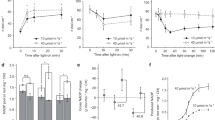Abstract
The pH-dependence of ADP and ATP affinity for CF1 tight nucleotide-binding sites was studied under conditions of equilibrium between bound and free labeled nucleotides. With the nucleotide/CF1 ratio>1, the ATP content in tightly bound nucleotides depended only slightly on medium pH. With the nucleotide/CF1 ratio approaching 1, tightly bound ATP content grew rapidly with decreasing pH. Calculations of ADP/ATP ratio in free and tightly bound nucleotides showed that decreasing the pH from 8.0 to 6.0 induced a 150 times greater affinity of the nucleotide-binding site for ATP than for ADP. The data indicates that ATP-ADP equilibrium at the CF1 tight nucleotide-binding site depends on protonation of specific acid-base groups of the enzyme.
Similar content being viewed by others
Abbreviations
- CF1, BF1, and MF1 :
-
coupling factors of chloroplasts, bacteria, and mitochondria, respectively
- AdN:
-
adenine nucleotide
References
Alberty RA (1968) Effect of pH and of metal ion concentration on the equilibrium of hidrolysis of ATP to ADP. J Biol Chem 243: 1337–1345
Binder A, Jagendorf AT and Ngo E (1978) Isolation and composition of the subunits of spinach chloroplasts coupling factor protein. J Biol Chem 253: 3094–3100
Boyer PD (1975) A model for conformational coupling of membrane potential and proton translocation to ATP synthesis and to active transport. FEBS Lett 58: 1–6
Bradford MM (1976) A rapid and sensitive method for the quantitation of microgram quantities of protein utilizing the principle of protein-dye binding. Anal Biochem 72: 248–254
Bronnikov GE and Zakharov SD (1983) Microquantitative determination of Pi-ATP and ADP-ATP exchange kinetics using thin-layer chromatography on silica gel. Anal Biochem 131: 69–74
Bruist MF and Hammes GG (1981) Further characterization of nucleotide binding sites on chloroplast coupling factor one. Biochemistry 20: 6298–6305
Cantley LG and Hammes GG (1975) Characterization of nucleotide binding sites on chloroplast coupling factor 1. Biochemistry 14: 2968–2975
Carlier MF and Hammes GG (1979) Interaction of nucleotides with chloroplast coupling factor 1. Biochemistry 18: 3446–3451
Feldman RI and Sigman DS (1982) The synthesis of enzyme-bound ATP by soluble chloroplast coupling factor 1. J Biol Chem 257: 1676–1683
Girault G, Galmiche G-M, Lemair C and Stulzaft O (1982) Binding and exchange of nucleotides on the chloroplast coupling factor CF1. Eur J Biochem 128: 405–411
Hammes GG (1983) Mechanism of ATP synthesis and coupled proton transport: studies with purified chloroplast coupling factor. TIBS 9: 131–134
Harris DA and Slater EC (1975) Tightly bound nucleotides of the energy transducting ATPase of chloroplasts and their role in photophosrylation. Biochim Biophys Acta 387: 335–348
Higashida M and Mucochata Y (1976) Magnesium-induced changes in the binding mode of adenilates to chloroplast coupling factor 1. J Biochem 80: 1177–1179
Kagawa Y (1984) A new model if proton motive ATP synthesis: acid-base cluster hypothesis. J Biochem 95: 295–298
Leckband D and Hammes GG (1987) Interactions between nucleotide binding sites on chloroplast coupling factor 1 during ATP hydrolysis. Biochemistry 26: 2306–2312
Malyan AN (1986) A possible coupling mechanism of ATP synthesis to proton transfer within chloroplast coupling factor CF1. Dokl Akad Nauk SSSR 291: 1015–1018 (in Russian)
Malyan AN and Vitseva OI (1983) Presteady-state kinetics of ATP hydrolysis by chloroplast CF1-ATPase. Biokhimiya 48: 718–724 (in Russian)
Malyan AN and Vitseva OI (1987) On the mechanism of regulation of catalytic activity of chloroplast coupling 1 ATPase. In: Biggins J (ed) Progress in Photosynthesis Research III, pp 121–124. Dordrecht: Martinus Nijhoff Publishers
Mitchell P (1974) A chemiosmotic molecular mechanism for proton translocating adenosine triphosphotase. FEBS Lett 43: 189–194
Mitchell P (1985) Molecular mechanics of protonmotive F1F0 ATPases. Rolling well and turnstile hypothesis. FEBS Lett 182: 1–7
Rosing J and Slater EC (1972) The value of G0 for the hydrolysis of ATP. Biochim Biophis Acta 267: 275–290.
Ryrie IJ and Gallaher A (1979) A yeast mitochondrial ATPase complex. Subunit composition and evidence for a latent protease contamination. Biochim Biophis Acta 545: 1–15
Sherman PA and Wimmer MJ (1984) Activation of ATPase of spinach coupling factor 1. Release of tightly bound ADP from the soluble enzyme. Eur J Biochem 139: 367–371
Shoshan V, Shavit N and Chipman DM (1978) Kinetics of nucleotide binding to chloroplast coupling factor (CF1). Biochim Biophis Acta 504: 108–122
Skulachev VP (1974) Mitochondrial adenosine triphosphatase, cytochrome c oxidase and bacteriorhodopsin as biological electric generators. Biochem Soc Spec Suppl (Great Britain) 4: 175–184
Strotmann H and Bickel-Sandkotter S (1977) Energy-dependent exchange of adenine nucleotides on chloroplast coupling factor (CF1). Biochim Biophis Acta 460: 126–135
Wu D and Boyer PD (1987) Bound adenosine 5-triphosphate formation, bound adenosine 5-diphosphate and inorganic phosphate retention, and inorganic phosphate-oxygen exchange by chloroplast adenosine triphosphatase in the presence of Ca2+ or Mg2+. Biochemistry 25: 3390–3396
Xue Z, Zhou JM, Miller CG and Boyer PD (1987) Catalytic and non-catalytic nucleotide binding sites of chloroplast F1 ATPase. FEBS Lett 223: 392–394
Author information
Authors and Affiliations
Rights and permissions
About this article
Cite this article
Malyan, A.N., Vitseva, O.I. pH dependent changes in ADP and ATP affinity for the tight nucleotide-binding site of chloroplast coupling factor 1. Photosynth Res 25, 11–16 (1990). https://doi.org/10.1007/BF00051731
Received:
Accepted:
Issue Date:
DOI: https://doi.org/10.1007/BF00051731




